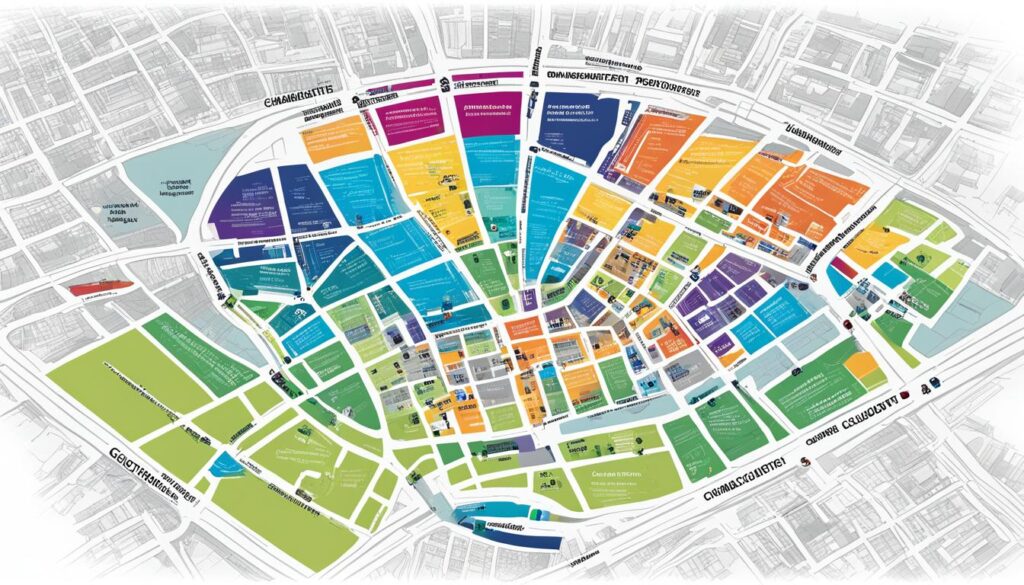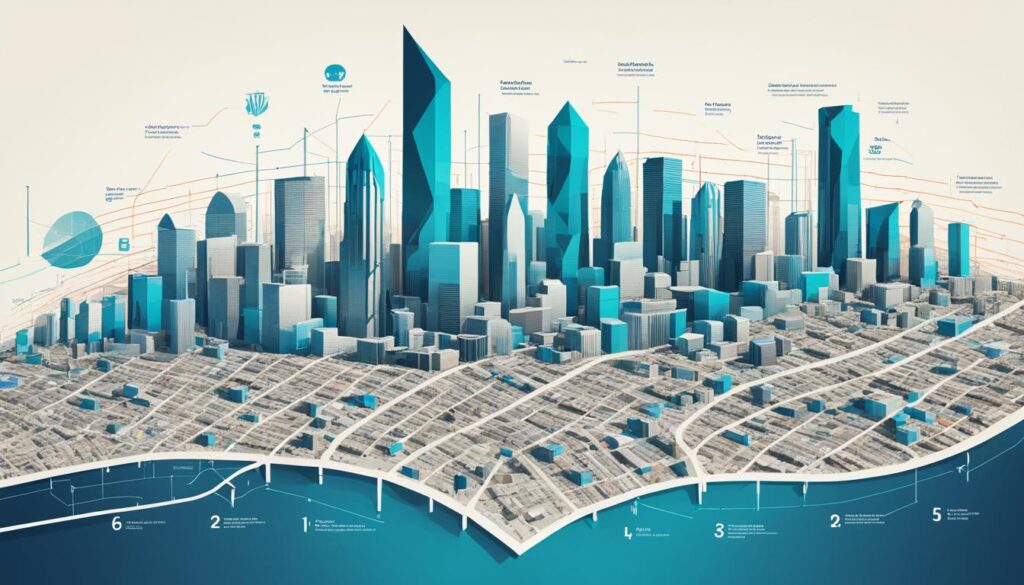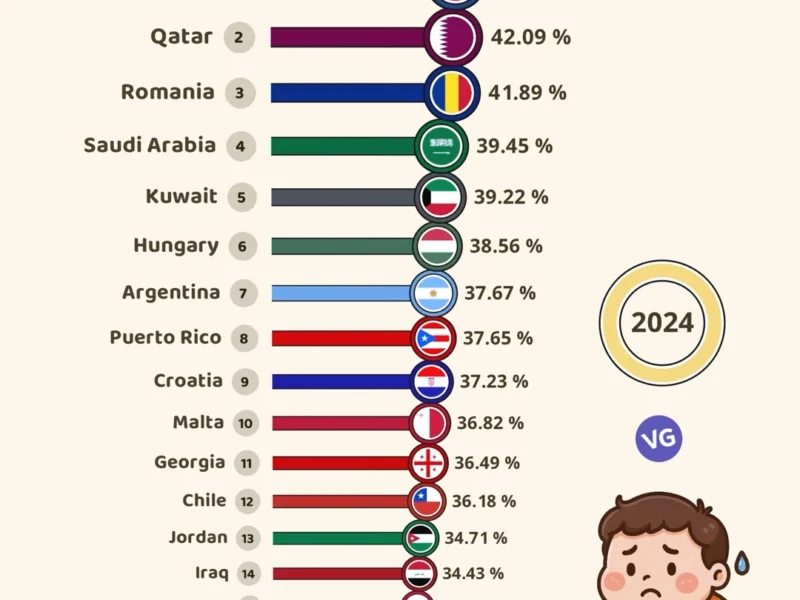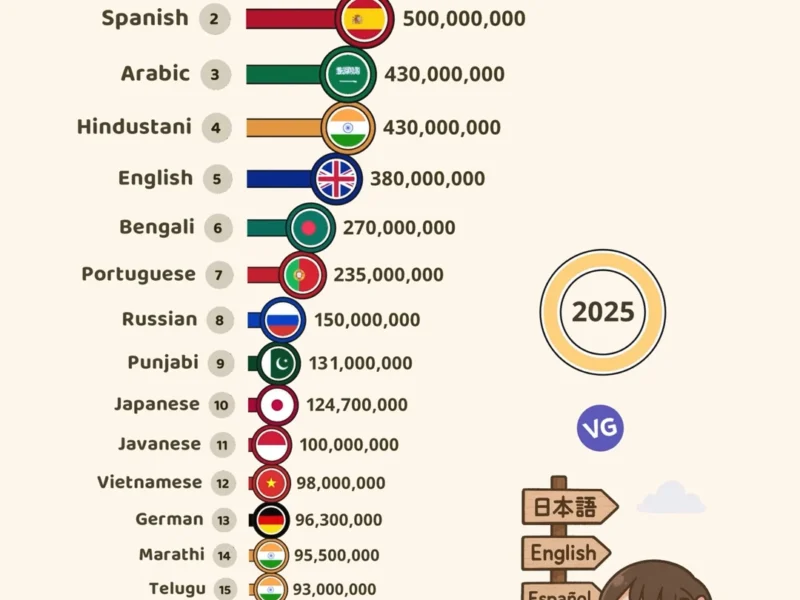Charlotte, North Carolina is on the rise, with an expected 917,000 people by 20241. It’s becoming one of the U.S.’s fastest-growing cities. The Charlotte metro area, including nearby suburbs, is set to hit about 2,321,000 people in 2024. This growth is driven by good jobs and a life that draws many.
This jump in population is because of the city’s strong economy. More jobs and a friendly business vibe are bringing in new folks. They’re also attracted by the city’s great lifestyle.
Key Takeaways
- Charlotte, NC’s population is projected to reach around 917,000 by 2024, reflecting its status as one of the fastest-growing cities in the US.
- The Charlotte metro area, including surrounding suburbs, is expected to have a population of approximately 2,321,000 in 2024.
- Population growth is driven by economic development, job opportunities, and an influx of new residents drawn to Charlotte’s quality of life and business climate.
- The city’s diverse racial composition includes 43.1% White, 35.21% Black or African American, and 6.55% Asian residents.
- Charlotte’s educational attainment levels are high, with 30.01% of adults holding a bachelor’s degree and 16.6% having a graduate degree.
Population Growth Trends of Charlotte
Charlotte has seen its population rise consistently over several decades. Since 1980, the number of people living here has tripled, going from 353,000 to an expected 917,000 in 20242. The recent growth was quite rapid, with the metro area increasing by 2.38% in 2024 alone2.
The story of growth isn’t new to Charlotte. For instance, years just past saw even bigger jumps, like 3.38% from 2021 to 2022 and 3.80% from 2020 to 20212.
Historical Population Data
From 1950 to current times, Charlotte has grown steadily2. Starting at 142,000 in 1950, it crossed 211,000 by 19602. Over the years, the growth rates varied from 2.08% to 5.16% every year2.
Recent Population Growth Rate
In 2024, the population of Charlotte is expected to hit 2,321,0002. This is a 2.38% jump from 2023, which had 2,267,000 people2. The increase has slowed down a bit from the previous year, which was 2.86%2.
The highest increases in population happened from 2011 to 2014. These years saw up to a 5.11% rise annually2.
Factors Influencing Population Growth
This city’s growth comes from many places. Things like a strong economy, jobs, and a good life quality bring folks in. Charlotte is also a popular spot for people moving from other places, both in the US and abroad2.
Racial Composition of Charlotte in 2024
Charlotte’s population in 2024 will be very mixed. No single group of people will be the majority.1 About 43.1% will be white, 35.21% will be black or African American, and 6.55% will be Asian.1 There will also be people from other races, including those with mixed heritage, making up 15.14%.1
White Population
In 2024, Charlotte will have 377,125 white residents. They will be 43.1% of the city’s population.1
Black or African American Population
The black or African American community will have 308,131 residents, making up 35.21% of the people in Charlotte.1
Asian Population
There will be 57,343 Asian residents living in Charlotte, which is 6.55% of the city’s population.1
Other Races
About 15.14% of Charlotte’s population will be from a variety of other racial backgrounds. This includes people of mixed races, Native Americans, and more.1 Specifically, there will be 66,765 residents of various races and 62,056 people who have mixed heritage.1

Age Distribution and Family Structures
In 2024, Charlotte’s population will have more younger people, with a median age of about 35 years old.3 A lot of people will be between 25 and 54 years old. This includes many kids and teenagers. People 65 and older will be a smaller part of the city, but their number is increasing.3
Charlotte Population Pyramid 2024
Charlotte, North Carolina, will have a varied age mix in 2024. Many will be in the working-age range.3The median age is estimated at 32.7 years,3 showing a younger population than the rest of the country.3
Household Types and Average Family Size
There is a mix of family and non-family homes in Charlotte.3On average, a home has 2.45 people, but families consist of 3.07 people.3 Around 61.4% of Charlotte’s homes are for families,3 with the rest being non-family homes.3
Marriage Rates and Marital Status
In Charlotte, more men than women are married, with 67.24% of men and 56.56% of women saying “I do.”1 This shows that many people still choose marriage, even if it’s not the same for all men and women in the city.1
Educational Attainment in Charlotte
Charlotte’s people are well-educated, more than the average American. By 2024, almost all adults there will have finished high school. This number is an impressive 97.7%.4 Also, 30.01% of adults have a bachelor’s degree. 16.6% have a higher degree, like a master’s or a Ph.D.4
High School Graduation Rates
The Charlotte-Mecklenburg schools are doing a good job. 86% of high school graduates continue to college for another year. And, 58% of them finish school with a degree or certificate in 6 years.4 Only 3% drop out, which is low for a big city.4
Bachelor’s and Graduate Degree Holders
After high school, Charlotte’s adults keep learning. A big 67.4% have a degree or some special training.4 This group includes 30.01% with a bachelor’s and 16.6% with a higher degree.4
Educational Attainment by Race
Yet, not everyone has the same chances. Data for Charlotte shows 40% of students’ parents didn’t go to college. This can make it harder for these students to succeed.4 Charlotte works hard to make sure everyone gets a fair shot at a good education. Special programs and services are helping students from all backgrounds.

population of charlotte nc 2024
By 2024, the Charlotte metro area could hit about 2,321,000 people. This number is 2.38% higher compared to 2023, when it had 2,267,000 residents.2
Charlotte Metro Area Population Projections
Charlotte’s metro area has been slowly growing. In 2023, it reached 2,267,000 residents, up by 2.86% from the year before.2 Growth rates were even higher in the past. Between 2021 and 2022, the population spiked by 3.38%. It increased by 3.8% from 2020 to 2021.2
Population Density and Urban Sprawl
With more people moving in, Charlotte and its suburbs are growing outward. The population’s growth has brought more buildings and people into the city and its outskirts. Expect this trend to keep going, making Charlotte one of the up-and-coming spots in the U.S.2
Income and Poverty Levels
Charlotte’s economic scene is varied, with both high and low-income families. In 2024, the city’s median household income is set to hit around $74,070. This is a bit more than the country’s average.1 But, incomes change a lot based on race and education levels.
Median Household Income
The latest numbers show families in Charlotte make about $93,023 a year.1 That’s more than what most families make nationwide. This shows the city’s strength in finance, tech, and professional services.
Poverty Rates by Race and Education
Poverty in Charlotte depends a lot on race and how much education people have. For example, 20.45% of Hispanics live in poverty1, while only 3.4% of Bachelor’s degree holders do.5 This really shows how Charlotte has big economic differences.
And poverty rates change by race too. White people have a poverty rate of 5.8%, Blacks have 13.98%, and “Others” 23.83%.5 These numbers clearly show the ongoing work needed to fix income inequality and fairness in Charlotte.
Income Distribution and Inequality
In Mecklenburg County, which includes Charlotte, families make a median of $100,267. The average, or mean, income is much higher at $144,173.5 This points to a big gap in incomes between different families within the area.
The education level also plays a big role in income differences. People with Bachelor’s degrees or more face less poverty, with a rate of only 3.4%.5

Employment and Labor Force
In 2024, Charlotte’s labor force participation rate is about 67.8%. This rate is a bit higher than the national average.6 Charlotte has a diverse job market. It includes finance, professional services, healthcare, and technology. These show Charlotte is a top spot for businesses and finance.6
Labor Force Participation Rate
The civilian labor force in the Charlotte-Concord-Gastonia area was between 1,451.9 and 1,467.5 thousand people in 2024.6 Jobs in the area varied from 1,406.2 to 1,420.7 thousand people. The unemployment rate was between 3.1% and 3.6%.6
Employment by Industry and Occupation
In Charlotte, jobs from all fields range between 1,342.1 and 1,368.8 thousand. A large group of those jobs, about 273.6 thousand, falls in Trade, Transportation, and Utilities.6
The Education and Health Services sector made up 145.6 thousand jobs, about 10%. And, Government jobs are around 174.9 thousand, making them a significant employer too.6
Unemployment Rates
In early 2024, Charlotte had a labor force of about 1,451.9 thousand to 1,467.5 thousand. This led to 45.7 thousand to 52.8 thousand people being jobless.7 The unemployment rate varied from 3.1% to 3.6%.7
Place of Birth and Migration Patterns
Charlotte’s folks come from near and far. Around 82.58% are American-born, with most, about 40.8%, from North Carolina.8 The other 17.42% come from other lands, mainly from Latin America. Europe, Asia, and Africa also add to the mix.1
Native-Born and Foreign-Born Population
In Charlotte, most people, about 82.58%, are born in the USA8. Yet, there’s a diverse 17.42% who are foreign-born. The bulk of them come from Latin America.1
Countries of Origin for Immigrants
Most of Charlotte’s immigrants hail from Latin America, forming the city’s biggest foreign group.1 Europe, Asia, and Africa also send significant numbers.
Domestic Migration Trends
Charlotte draws many from across the U.S., with 59.2% not from North Carolina.8 They come for the city’s growing business and economic opportunities. This migration helps fuel Charlotte’s growth.
Veteran Population in Charlotte
By 2024, there were around 35,163 veterans living in Charlotte.9 They make up about 4.8% of the city’s people.10 This number is similar to North Carolina’s average, where about 7.5% of adults are veterans.10
Veterans by War
The most veterans in Charlotte served in the Second Gulf War, around 10,036.9 Next came the Vietnam War with 9,084 veterans, then the First Gulf War with 8,895.9 Fewer veterans served in Korea, World War II, and other battles.9
Age Distribution of Veterans
Veterans in Charlotte are of various ages, much like the rest of the country.11 The Veteran Population Projection Model 2020 looks at past and future veteran numbers. It considers age, gender, when they served, and their backgrounds.11
Educational Attainment and Employment of Veterans
Charlotte’s veterans are well-educated and have good jobs.10 In 2022, about 32.40% of North Carolina’s veterans over 25 had a bachelor’s degree. This was just a bit less than non-veterans at 36.20%.10 The jobless rate for vets in 2022 was lower too, at 3.00%, compared to 3.80% for non-veterans.10
Conclusion
Charlotte, North Carolina, will see more people moving in. By 2024, it might have 917,000 residents. More folks are choosing Charlotte because of jobs and its charm. Both from the U.S. and from other countries, people are coming here.12 The areas around Charlotte are growing too. It’s not just the city but also the places nearby. They expect about 2,321,000 people living there by 2024, up from 2,267,000 in 2023. This tells us lots of people are moving into the whole area, not just the city.13 Many things drive this growth. Good job chances and how nice it is to live here. People also like that Charlotte is great for doing business.
Charlotte keeps a mix of different kinds of people, with no one group being most of the population. It has many adults working and plenty of kids and teens too. This mix shows that Charlotte attracts families and young folks starting their careers.12 Lots of people here have gone to college. They’ve earned bachelor’s and more advanced degrees too.
In the end, Charlotte’s tomorrow looks good. It is still bringing in more folks and companies. This strengthens its place as a fast-growing, exciting part of the U.S.13 This growth and all the changes will be key in shaping Charlotte’s future. It brings chances but also some things to think about for the city’s leaders and the people living here.
FAQ
What is the projected population of Charlotte, North Carolina in 2024?
By 2024, Charlotte, North Carolina, could have about 917,000 people. This is the latest prediction.
What is the expected growth rate of the Charlotte metropolitan area from 2023 to 2024?
The Charlotte metro area might grow to roughly 2,321,000 people by 2024. In 2023, it had about 2,267,000 residents. This suggests growth of 2.38% from 2023 to 2024.
What is the racial composition of Charlotte’s population projected to be in 2024?
In 2024, Charlotte’s population will be a mix of people. About 43.1% will be white, while 35.21% will be black or African American. Additionally, 6.55% will be Asian, and the rest, 15.14%, will be from various other races.
What is the projected age distribution of Charlotte’s population in 2024?
Charlotte’s population will be quite young in 2024, with a median age of around 35. It will have many people between 25 and 54 years. There will also be lots of children and teenagers. But, the group of older adults, 65 and above, is also growing, though it’s smaller.
What is the educational attainment level of Charlotte’s population projected to be in 2024?
By 2024, most adults in Charlotte will be well-educated. Around 97.7% will have finished at least high school. Additionally, 30.01% will have a bachelor’s degree, and 16.6% will have a graduate or professional degree.
What is the projected median household income for Charlotte in 2024?
By 2024, the median household income in Charlotte could be ,070. This is a bit more than the average income across the U.S.
What is the labor force participation rate expected to be in Charlotte in 2024?
Based on estimates, about 67.8% of Charlotte’s adults will be in the labor force in 2024. This rate is higher than the national average.
What is the proportion of native-born versus foreign-born residents in Charlotte’s population?
About 82.58% of Charlotte’s people were born in the U.S. Of that, 40.8% are native to North Carolina. The other 17.42% are from outside the U.S. Most of them are from Latin America, with others coming from Europe, Asia, and Africa.
What is the estimated veteran population in Charlotte as of 2024?
In 2024, Charlotte may have roughly 35,163 veterans. Many of these veterans served in the Second Gulf War. Others served in the Vietnam War and the First Gulf War.
Source Links
- https://worldpopulationreview.com/us-cities/charlotte-nc-population
- https://www.macrotrends.net/global-metrics/cities/22954/charlotte/population
- https://www.infoplease.com/us/census/north-carolina/charlotte/demographic-statistics
- https://dashboard.myfuturenc.org/wp-content/uploads/county-profiles/Mecklenburg_County.pdf
- https://worldpopulationreview.com/us-counties/nc/mecklenburg-county-population
- https://www.bls.gov/eag/eag.nc_charlotte_msa.htm
- https://www.bls.gov/regions/southeast/nc_charlotte_msa.htm
- https://charlotteregion.com/news/2024/04/18/alliance-news/who-s-moving-here-a-closer-look-at-population-trends-in-the-charlotte-region/
- http://censusreporter.org/profiles/16000US3712000-charlotte-nc/
- https://usafacts.org/topics/veterans/state/north-carolina/
- https://www.va.gov/vetdata/veteran_population.asp
- https://en.wikipedia.org/wiki/Charlotte,_North_Carolina
- https://kiss951.com/2024/03/17/the-population-of-this-north-carolina-area-is-exploding-and-heres-where-people-are-coming-from/


